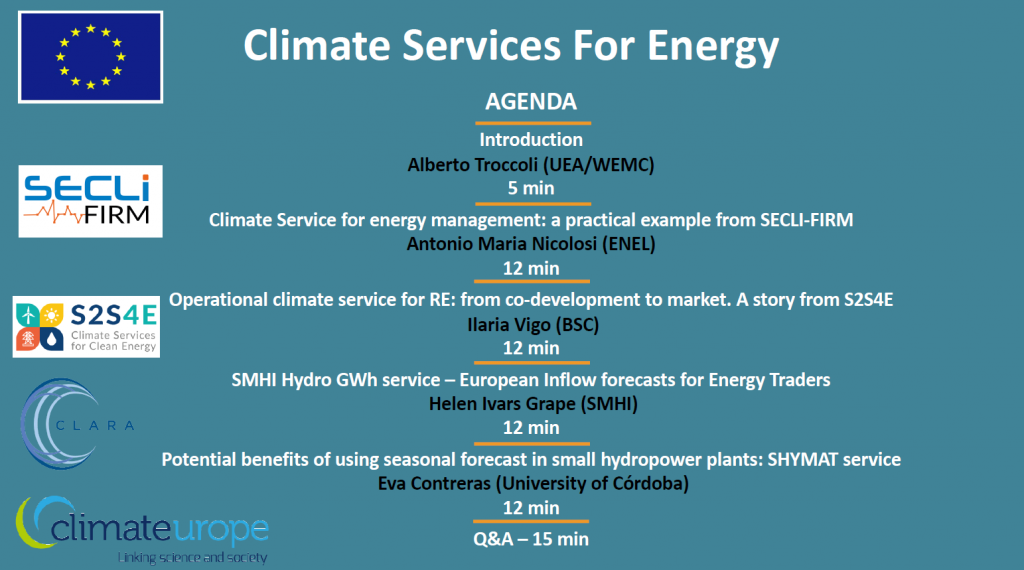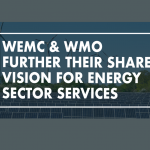SECLI-FIRM Webinar Overview: Climate Services for the Energy Industry
Projects are at the core of WEMC work and we are the lead on stakeholder engagement, communications and exploitation of results for the EU H2020 SECLI-FIRM Project.
On Thursday 3 September 2020 we went live with the latest SECLI-FIRM webinar in collaboration with Climateurope. The focus of the webinar was how EU projects have developed innovative climate services for the energy industry. The webinar was part of the ‘Climate Thursdays’ series.
This opportunity to hear several speakers share their knowledge in one forum, that demanded only an hour of their time, was well-received for the first autumnal webinar in the #ClimateThursdays series and the second free webinar led by the SECLI-FIRM project team.
Alberto Troccoli (WEMC/UEA) chaired the webinar, introduced the SECLI-FIRM Project and welcomed four expert presenters.
It was a packed and informative agenda:

Antonio Maria Nicolosi from the SECLI-FIRM project partner ENEL presented ‘Climate Service for energy management: a practical example from SECLI-FIRM.’ ENEL, an energy company, is an industry partner across five of the nine project case studies.
During his talk Antonio focused on the process from the conception to the creation of a climate service. He introduced how ENEL ‘middle office’ working with SECLI-FIRM and the World Energy & Meteorology Council (WEMC) has developed a climate service tool that can inform market decisions. He summarised the feedback ENEL provided to ensure the service best met their needs. He also emphasised the importance of ease of use and access to data and how the tool can help speed up the sharing process between meteorologists and traders.
Further presentations featuring EU projects, included Ilaria Vigo with a story from the S2S4E project about an ‘Operational climate service for renewable energy: from co-development to market.’ Ilaria introduced the Decision Support Tool (DST) an operational climate service that integrates, for the first time, sub-seasonal to seasonal climate predictions with renewable energy production and electricity demand. She talked through the five steps taken for the co-creation of the DST from user needs to feedback and application (view the full presentation here).
Next we heard from Helen Ivars Grape from SMHI and learnt more about the GWh Service developed through the Clara Project, including future plans. She also addressed how climate services can help energy traders and hydropower production planners. Access the full presentation here, which also includes an interesting historical introduction to the hydrology unit at SHMI, started in 1908.
The final presentation was from Eva Contreras, University of Córdoba and explored the SHYMAT service (Clara Project) and specifically the potential benefits of using seasonal forecast data to inform decision-making in small hydropower plants. Eva tackled the main challenges that need to be overcome to drive innovation and move away from old habits and reliance on in-house evaluations only. Discover more in her presentation.
We were joined by over 50 attendees on the live webinar and our thanks go to each of them and our guest presenters as they contributed to a lively Q&A. Our participants were encouraged to make the most of access to our speakers and they certainly did with climate service questions on the presenters’ experience of the co-production process, the reproduction of processes and the extension of services into new territories.
The recording is available here and all the presentations here (select the Webinar tab).
Stay up to date on SECLI-FIRM opportunities including events and project publications:
Subscribe to the newsletter
Follow SECLI-FIRM on Twitter and LinkedIn
Visit secli-firm.eu or contact lucy.haughey@wemcouncil.org for more project information.



